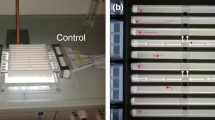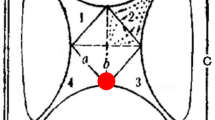Abstract
Two pine shoot beetles, Tomicus yunnanensis and Tomicus minor, are the most destructive pests of Pinus yunnanensis in southwestern China. We investigated behavioral responses within and between these two species during the shoot-feeding phase using walking bioassays. We also identified the pheromonal aspects of beetles by static solid phase microextraction (SPME) and hindgut extraction following interactive communication by gas chromatography-mass spectroscopy (GC-MS). Both species were significantly attracted by their own species and the same sex, and attraction was inhibited by exposure to additional beetles or to the hindgut extracts of beetles which had shown interaction. Female and male T. minor and T. yunnanensis hindguts contained 0.19, 0.09, 0.22, and 0.05 ng/individual of (−)-trans-verbenol, respectively; following interaction with additional beetles, this increased to 16.74–292.71 ng/individual in T. minor females. Mean concentration of verbenone detected in the hindguts of female/male individuals of T. minor and T. yunnanensis under natural conditions were 0.16, 0.06, 0.03, and 0.05 ng/individual, respectively, but these correspondingly increased to 5.90, 2.43, 0.06, and 0.19 ng/individual after exposure to additional insects. In T. yunnanensis, the amounts of detectable (−)-trans-verbenol and verbenone extracted from hindguts were lower than those from T. minor. The levels of cis-verbenol and (−)-trans-verbenol most attractive to walking T. yunnanensis and T. minor were 0.1 and 1.0 ng/μl, respectively. Verbenone was not attractive at any of the concentrations tested. The addition of verbenone to cis-verbenol or (−)-trans-verbenol reduced the attraction responses. We conclude that the (−)-trans-verbenol produced by these two pine shoot beetles is attractive at low concentrations and repellant at high concentrations, thereby fostering intraspecific competition. Verbenone is produced to prevent overcrowding via interspecific inhibition, and to expel beetles during shoot-feeding.








Similar content being viewed by others
References
Aurélien S, Raffa KF (2010) Interactions among intraspecific competition, emergence patterns, and host selection behaviour in Ips pini (Coleoptera: Scolytinae). Ecol Entomol 32(2):162–171
Ayres BD, Abrahamson MD, Teale SA (2001) Resource partitioning and overlap in three sympatric species of Ips bark beetles (Coleoptera: Scolytidae). Oecologia (Berlin) 128(3):443–453
Berryman AA, Pienaar LV (1973) Simulation of intraspecific competition and survival of Scolytus ventralis broods (Coleoptera: Scolytidae). Environ Entomol 2:447–460
Browne LE, Wood DL, Bedard WD, Silverstein RM, West JR (1979) Quantitative estimates of the western pine beetle attractive pheromone components, exo-brevicomin, frontalin, and myrcene in nature. J Chem Ecol 5:397–414
Byers JA (1981) Effect of mating on terminating aggregation during host colonization in the bark beetle, Ips paraconfusus. J Chem Ecol 7:1135–1147
Byers JA (2012) Bark beetles, Pityogenes bidentatus, orienting to aggregation pheromone avoid conifer monoterpene odors when flying but not when walking. Psyche J Entomol:1–10. https://doi.org/10.1155/2012/940962
Byers JA, Wood DL (1981) Interspecific effects of pheromones on the attraction of the bark beetles, Dendroctonus brevicomis and Ips paraconfusus in the laboratory. J Chem Ecol 7:9–18
Byers JA, Wood DL, Craig J, Hendry LB (1984) Attractive and inhibitory pheromones produced in the bark beetle, Dendroctonus brevicomis, during host colonization: regulation of inter-and intraspecific competition. J Chem Ecol 10:861–877
Byers JA, Lanne BS, Löfqvist J, Schlyter F, Bergström G (1985) Olfactory recognition of host-tree susceptibility by pine shoot beetles. Naturwissenschaften 72:324–326
Byers JA, Högberg HE, Unelius CR, Birgersson G, Löfqvist J (1989) Structure-activity studies on aggregation pheromone components of Pityogenes chalcographus (Coleoptera: Scolytidae). J Chem Ecol 15:685–695
Byers JA, Birgersson G, Francke W (2013) Aggregation pheromones of bark beetles, Pityogenes quadridens and P. bidentatus, colonizing Scotch pine: olfactory avoidance of interspecific mating and competition. Chemoecology 23:251–261
Byers JA, Maoz Y, Wakarchuk D, Fefer D, Levi, Zada A (2018) Inhibitory effects of semiochemicals on the attraction of an ambrosia beetle Euwallacea, nr. fornicatus, to quercivorol. J Chem Ecol:1–11. https://doi.org/10.1007/s10886-018-0959-8
Devlin DR, Borden JH (1994) Efficacy of antiaggregants for the pine engraver, Ips pini (Coleoptera: Scolytidae). Can. J Forest Res 24:2469–2476
Duan Y, Kerdelhué C, Ye H, Lieutier F (2004) Genetic study of the forest pest Tomicus piniperda (Col., Scolytinae) in Yunnan province (China) compared to Europe: new insights for the systematics and evolution of the genus Tomicus. Heredity 93:416
Etxebeste I, Pajares JA (2011) Verbenone protects pine trees from colonization by the six–toothed pine bark beetle, Ips sexdentatus Boern. (Col.: Scolytinae). J Appl Entomol 135:258–268
Fettig CJ, Mckelvey SR, Dabney CP, Borys RR, Huber DPW (2009) Response of Dendroctonus brevicomis to different release rates of nonhost angiosperm volatiles and verbenone in trapping and tree protection studies. J Appl Entomol 133:143–154
Francke W, Heemann V (1976) Das Duftstoff-bouquet des Großen Waldgärtners Blastophagus piniperda L. (Coleoptera: Scolytidae). J Appl Entomol 82:117–119
Hulcr J, Mann R, Stelinski LL (2011) The scent of a partner: ambrosia beetles are attracted to volatiles from their fungal symbionts. J Chem Ecol 37:1374–1377
Hunt DWA, Borden JH (1989) Terpene alcohol pheromone production by Dendroctonus ponderosae and Ips paraconfusus (Coleoptera: Scolytidae) in the absence of readily culturable microorganisms. J Chem Ecol 15:1433–1463
Khan ZR, James DG, Midega CAO, Pickett JA (2008) Chemical ecology and conservation biological control. Biol Control 45(2):210–224
Kirkendall LR, Faccoli M, Ye H (2008) Description of the Yunnan shoot borer, Tomicus yunnanensis Kirkendall & Faccoli sp. n. (Curculionidae, Scolytinae), an unusually aggressive pine shoot beetle from southern China, with a key to the species of Tomicus. Zootaxa 1819:25–39
Kuhns EH, Tribuiani Y, Martini X, Meyer WL, Peña J, Hulcr J, Lukasz LS (2014) Volatiles from the symbiotic fungus Raffaelea lauricola are synergistic with manuka lures for increased capture of the redbay ambrosia beetle Xyleborus glabratus. Agri. Forest Entomol 16:87–94
Lacey ES, Ginzel MD, Millar JG, Hanks LM (2004) Male-produced aggregation pheromone of the cerambycid beetle Neoclytus acuminatus acuminatus. J Chem Ecol 30(8):1493–1507
Långström B, Hellqvist C (1993) Induced and spontaneous attacks by pine shoot beetles on young scots pine trees: tree mortality and beetle performance. J Appl Entomol 115:25–36
Långström B, Lisha L, Hongpin L, Peng C, Haoran L, Hellqvist C, Lieutier F (2002) Shoot feeding ecology of Tomicus piniperda and T. minor (Col., Scolytidae) in southern China. J Appl Entomol 126:333–342
Lanne BS, Schlyter F, Byers JA, Löfqvist J, Leufvén A, Bergström G, der Pers JNC V, Unelius R, Baeckström P, Norin T (1987) Differences in attraction to semiochemicals present in sympatric pine shoot beetles, Tomicus minor and T piniperda. J Chem Ecol 13:1045–1067
Li X, Zhang Z, Wang HB, Wu W, Cao P, Zhang PY (2010) Tomicus armandii Li & Zhang (Curculionidae, Scolytinae), a new pine shoot borer from China. Zootaxa 2572(2572): 57–64
Lieutier F, Ye H, Yart A (2003) Shoot damage by Tomicus sp. (Coleoptera: Scolytidae) and effect on Pinus yunnanensis resistance to subsequent reproductive attacks in the stem. Agr. Forest Entomol 5:227–233
Light DM, Birch MC, Paine TD (1983) Laboratory study of intraspecific and interspecific competition within and between two sympatric bark beetle species, Ips pini and I paraconfusus. J Appl Entomol 96:233–241
Lindgren BS, Miller DR (2015) Effect of verbenone on five species of bark beetles (Coleoptera: Scolytidae) in lodgepole pine forests. Environ Entomol 31:759–765
Liu Z, Zhang L, Sun J (2006) Attacking behavior and behavioral responses to dust volatiles from holes bored by the red turpentine beetle, Dendroctonus valens (Coleoptera: Scolytidae). Environ Entomol 35:1030–1036
Liu H, Zhang Z, Ye H, Wang HB, Clarke SR, Lu J (2010) Response of Tomicus yunnanensis (Coleoptera: Scolytinae) to infested and uninfested Pinus yunnanensis bolts. Forest Entomol 103:95–100
Lu J, Zhao T, Ye H (2014) The shoot-feeding ecology of three Tomicus species in Yunnan Province, southwestern China. J Insect Sci 14:37. https://doi.org/10.1093/jis/14.1.37
Miller KR, Cowles RS (1990) Stimulo-deterrent diversion: a concept and its possible application to onion maggot control. J Chem Ecol 16(11):3197–3212
Miller DR, Rabaglia RJ (2009) Ethanol and (−)-α-pinene: attractant kairomones for bark and ambrosia beetles in the southeastern US. J Chem Ecol 35(4):435–448
Payne TL, Coster JE, Richerson JV, Edson LJ, Hart ER (1978) Field response of the southern pine beetle to behavioral chemicals. Environ Entomol 7:578–582
Peverieri GS, Faggi M, Marziali L, Panzavolt T, Bonuomo L, Tiberi R (2016) Use of attractant and repellent substances to control Tomicus destruens (Coleoptera: Scolytidae) in Pinus pinea and P. pinaster pine forests of Tuscany. Entomologica 38:91–102
Pitman GB, Vité JP, Kinzer GW, Fentiman AF (1969) Specificity of population-aggregating pheromones in Dendroctonus. J Insect Physiol 15:363–366
Poland TM, De Groot P, Burke S, Wakarchuk D, Haack RA, Nott R, Scarr T (2003) Development of an improved attractive lure for the pine shoot beetle, Tomicus piniperda (Coleoptera: Scolytidae). Agr Forest Entomol 5:293–300
Renwick JAA (1967) Identification of two oxygenated terpenes from the bark beetles Dendroctonus frontalis and Dendroctonus brevicomis. Contrib. Boyce Thompson Inst 23:355–360
Rudinsky JA (1973) Multiple functions of the southern pine beetle, pheromone verbenone. Environ Entomol 2:511–514
Ryker LC, Yandell KL (1983) Effect of verbenone on aggregation of Dendroctonus ponderosae Hopkins (Coleoptera, Scolytidae) to synthetic attractant. J Appl Entomol 96:452–459
Seybold SJ, Huber DPW, Lee JC, Graves AD, Bohlmann J (2006) Pine monoterpenes and pine bark beetles: a marriage of convenience for defense and chemical communication. Phytochem Rev 5:143–178
Smith MT, Payne TL, Borch MC (1990) Olfactory-based behavioral interactions among five species in the southern pine bark beetle group. J Chem Ecol 16:3317–3331
Sun JH, Clarke SR, Kang L, Wang HB (2005) Field trials of potential attractants and inhibitors for pine shoot beetles in the Yunnan province, China. Ann Forest Sci 62:9–12
Wang J, Zhang Z, Kong X, Wang H, Zhang S (2015) Intraspecific and interspecific attraction of three Tomicus beetle species during the shoot-feeding phase. Bull Entomol Res 105:225–233
Wei J, Shao W, Wang X, Ge J, Chen X, Yu D, Kang L (2017) Composition and emission dynamics of migratory locust volatiles in response to changes in developmental stages and population density. Insect Sci 24(1):60–72
Wood SL, Bright DE (1992) A catalogue of Scolytidae and Platypodidae (Coleoptera), part 2: taxonomic index. Vols A and B Great Basin Nat Mem 13:1–1553
Ye H, Ding XS (1999) Impacts of Tomicus minor on distribution and reproduction of Tomicus piniperda (Col., Scolytidae) on the trunk of the living Pinus yunnanensis trees. J Appl Entomol 123:329–333
Ye H, Lieutier F (1997) Shoot aggregation by Tomicus piniperda L (col: Scolytidae) in Yunnan, southwestern China. Ann. For Sci 54:635–641
Zhang LY, Chen QC, Zhang XB (2006) Studies on the morphological characters and bionomics of Dendroctonus valens LeConte. Sci Silvae Sinicae 38:95–99
Acknowledgements
The authors would like to thank two anonymous reviewers for their comments which significantly improved the manuscript. We also sincerely thank Sun Fucun and Wang Huiming for their assistance during the fieldwork. This study was supported by the National Natural Science Foundation of China (grant no. 31370655).
Author information
Authors and Affiliations
Corresponding authors
Electronic supplementary material
ESM 1
(DOCX 86 kb)
Rights and permissions
About this article
Cite this article
Wu, C.X., Liu, F., Zhang, S.F. et al. Semiochemical Regulation of the Intraspecific and Interspecific Behavior of Tomicus yunnanensis and Tomicus minor during the Shoot-Feeding Phase. J Chem Ecol 45, 227–240 (2019). https://doi.org/10.1007/s10886-019-01048-6
Received:
Revised:
Accepted:
Published:
Issue Date:
DOI: https://doi.org/10.1007/s10886-019-01048-6




